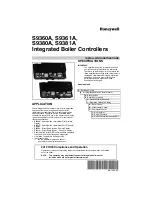
CONTROL METHODS
HeatNet Control V3
Page 25
Input Priorities
The FlexCore CK-Series
control inputs are
prioritized
so
that multiple levels of external control can be employed at
the same time. This means that if we are firing the boiler
with a low Priority input and a higher Priority input is called
for, the boiler will now fire at the higher Priority input.
When the high Priority input is removed, the boiler will
revert back to the lower Priority input that is still called.
Priority 1
The AA terminal has absolute control, and if used, will
always fire the boiler at 100% output, regardless of any
other input. The 4-20 mA input may be raised to this
Priority using
SETTINGS: 4-20 mA INPUT:
PRIORITY
.
Priority 2
The HEAT DEMAND input is the next, and provides the
means to operate the boiler in LOCAL MODE when an
external control is not present, has failed, or needs to be
enabled or disabled. A member can override the H-Net
commands using this input.
Priority 3
If a HeatNet (H-Net) Network cable is connected between
boilers, and one is configured as a MASTER (requires
HEADER sensor), then the MEMBER boilers will be
controlled over the network by the MASTER.
Priority 4
The 4-20 mA/0-10VDC input in tandem with the 4-20 mA
REMOTE ENABLE input is next. Any signal over 4.02 mA
or 2.01VDC will start and operate the boiler if the
REMOTE ENABLE is closed.
Priority 5
The lowest Priority is using the boiler as (2) stages
HIGH/LOW. These are the T1 and T2 inputs.
Each of these control methods will now be explained in
more detail:
Heating Method 1
HEAT DEMAND
Closing a relay contact, switch, or jumper across the HEAT
DEMAND input will enable this method. This method
allows operation as a setpoint control. As a setpoint control,
the Master (defined by having a common system supply
header sensor), on the H-Net network can command the
boiler fire rate of all Member boilers. The Master can call as
many boilers that it has available (boilers are auto-detected
over the H-Net cable by the Master) to meet its
SYSTEM
SETPOINT
. The H-Net cable must be connected and will
cause the amber light on the communications board to flash.
The amber light indicates an H-Net Master is broadcasting
control information and a system heartbeat.
The AA terminal, the FAILSAFE mode active, 4-20 mA at
PRIORITY: HIGHEST, and the HEAT DEMAND input
(LOCAL) on a Member, are the only inputs that will
override the H-Net control.
Heat demand input
MEMBER: Close to run at Local setpoint.
MASTER: Close to control all boilers and
run at System setpoint.
Master boiler
The MASTER boiler controls the system using a PID
algorithm. Once the boiler is started, a PID algorithm is
used to produce a modulation percentage value from 0-
100%. This percentage is converted to a PWM, (P)ulse
(W)idth (M)odulation signal by each boiler. The
temperature of the water is maintained by sending this
PWM signal to the Variable Frequency Drive, which in turn
controls the blower motor. Since the main fuel valve is air-
fuel coupled to the blower, the speed of the blower provides
the firing rate.
Member boiler(s)
A Member (lacking a common system supply header
sensor) boiler may also be controlled by the HEAT
DEMAND input (LOCAL mode). The member boiler will
then ignore commands from the Master and maintain its
own LOCAL SETPOINT at its supply sensor. This can be
viewed as a manual override on a member boiler. Be sure to
observe the proper use of a Common System Damper (See:
AUXILIARY FUNCTION OPTIONS section) and any
system pumps or system common interlocks.
HeatNet Boilers Configured as Reverse Return
Lo
ca
l P
u
m
p
Lo
ca
l P
u
m
p
MASTER
MEMBER
1
HNET
HNET
Space Heating
Loop
H
ea
de
r
Se
n
so
r
MEMBER
2
MEMBER
3
Sy
st
em
R
et
u
rn
S
en
so
r
HNET
Lo
ca
l P
u
m
p
Lo
ca
l P
u
m
p
Sy
st
em
P
u
m
p
















































